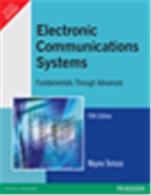Electronic Communications System: Fundamentals Through Advanced, 5/e

|
Author(s):
Author:
Wayne Tomasi
- ISBN:9788131719534
- 10 Digit ISBN:8131719537
-
Price:Rs. 1130.00
- Pages:1184
- Imprint:Pearson Education
- Binding:Paperback
- Status:Available
-
|
Comprehensive in scope and contemporary in coverage, this text introduces basic electronic and data communications fundamentals, and explores their application in modern digital and data communications systems. Students with previous knowledge in basic electronic principles and fundamental calculus concepts will gain a complete understanding of the topics presented here. Tomasi's Advanced Electronic Communications Systems 6/e is the last 10 chapters of this text.
Table of Content
- Introduction to Electronic Communications.
- Signal Analysis and Mixing.
- Oscillators, Phase–Locked Loops, and Frequency Synthesizers.
- Amplitude Modulation Transmission.
- Amplitude Modulation Reception.
- Single–Sideband Communications Systems.
- Angle Modulation Transmission.
- Angle Modulation Reception and FM Stereo.
- Digital Modulation.
- Digital Transmission.
- Digital T-Carriers and Multiplexing.
- Metallic Cable Transmission Media.
- Optical Fiber Transmission Media.
- Electromagnetic Wave Propagation.
- Antennas and Waveguides.
- Telephone Instruments and Signals.
- The Telephone Circuit.
- The Public Telephone Network.
- Cellular Telephone Concepts.
- Cellular Telephone Systems.
- Introduction to Data Communications and Networking
- Fundamental Concepts of Data Communications.
- Data–Link Protocols and Data Communications Networks.
- Microwave Radio Communications and System Gain.
- Satellite Communications.
- Satellite Multiple Accessing Arrangements.
|
Salient Features
- Rewritten material on satellites—Includes their history; orbits; elevation categories; orbital patterns; and antenna look angles.
- Materials in the Fundamentals chapters on AM envelopes—Produced by complex nonsinusoidal signals, Quadrature Amplitude Modulation, noise limiters and blankers, alternate signal-to-noise measurements, single-sideband suppressed carrier, frequency division multiplexing, double-sideband suppressed carrier, quadrature multiplexing, microstrip, and stripline.
- Material in the Advanced chapters—On trellis encoding, CCITT modem recommendations, PCM line speed, extended superframe format, wavelength division multiplexing, Kepler's laws, Clark orbits, limits of visibility, Satellite Radio Navigation and Navstar GPS.
- Optical fiber communications has been moved from Chapter 20 to Chapter 11—Includes new sections on light sources, optical power, optical sources and link budget.
|
|
|
|
|